L-3
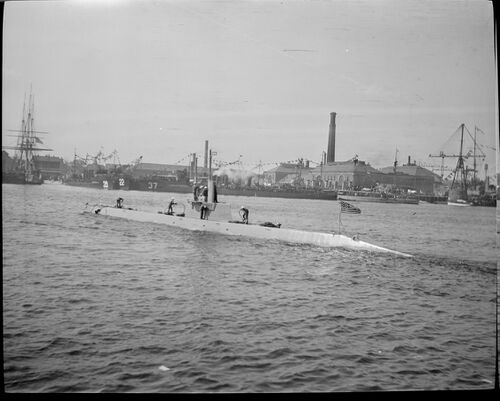
Photo courtesy of the Massachusetts Digital Commonwealth.
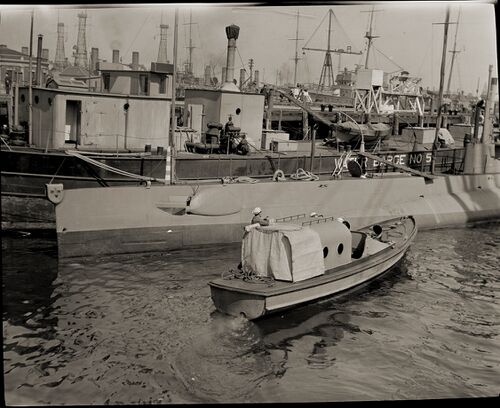
L-3 moored alongside Water Barge No. 5 at the Charlestown Navy Yard, summer 1916. Details of the distinctive towing fairlead at the tip of the bow, and of the folded bow planes can be seen. An officer's gig is maneuvering alongside.
Photo courtesy of the Massachusetts Digital Commonwealth..

Another view of L-3 alongside at Charlestown, summer 1916. This yard was a busy place at this time, with many ships in for work as the U.S. Navy prepared itself for a war that many hoped would not come their way.
Photo courtesy of the Massachusetts Digital Commonwealth.
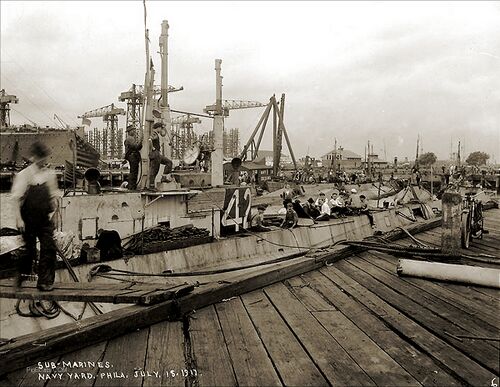
L-3 is seen here on July 18, 1917 at the Philadelphia Navy Yard undergoing a pre-deployment overhaul. Both of the L-3's periscopes can be seen. These are non-housing types that do not raise or lower. Once the boats arrived in the war theater in Europe they would be changed out for housing-type periscopes. Between the two scopes can be seen the upper edge of the conning tower, with two deadlight windows and the open top hatch. The conning tower was very small, not much more than an access trunk. The US entered WW I on April 6, 1917 and submarines were to be deployed to the Azores and Ireland to patrol the waters and deny access and free reign to the German U-Boats. In the background can be seen the submarine K-5 (Submarine No. 37) with the number 37 painted on her conning tower fairwater. There are at least four more submarines in the photo but they can't be identified. A vintage motorcycle is parked on the pier.
U.S. Navy photo.
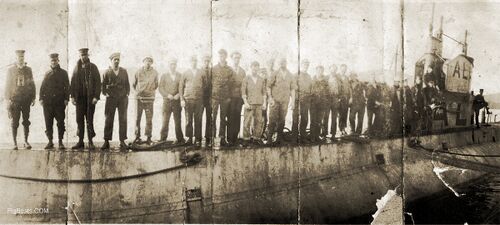
The man on the far right has his foot up on a lifeline stanchion. Under the bend of his leg can be seen the barrel of the 3"/23 caliber Mk 9 deck gun. This gun retracted into the deck with the barrel pointing straight up. The original photo is in bad condition and is very fragile. This accounts for the lines and damages to the photo.
Photo in the private collection of Ric Hedman.

L-3 during a visit to Plymouth, England, August 1918. The American boats operating in the war zone were based in Bantry Bay, Ireland, but they occasionally made a visit to other British ports.
Photo in the private collection of Ric Hedman.
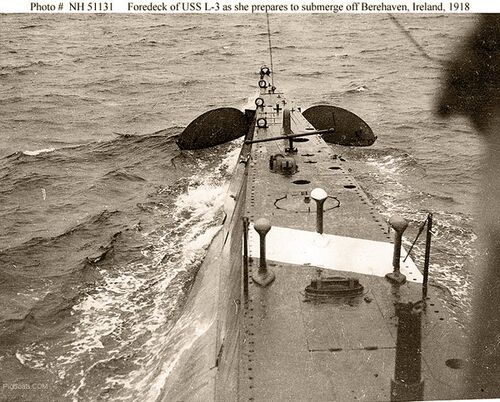
L-3 underway off Berehaven, Ireland, 1918. She is in the process of diving. The photographer has captured the bow diving planes half rigged out. The T-shaped SC sonar array is just visible on the deck aft of the planes. This passive array was the first trainable array, and could give the operator rough bearings to a target. The three football shaped domes near the white stripe are for the K-tube sonar. Using a different method this array could also give a bearing to a target, accurate to a few degrees. The purpose of the white stripe is not known. Just aft of the white stripe is the torpedo loading hatch, and aft of that is the vertical barrel of the retracted 3"/23 caliber gun. There is a tampion in the barrel.
Just forward of the SC array is the towing padeye. The series of rings on the port side of the bow were used to secure a towing hawser when not in use.
Photo NH 51131 courtesy of NHHC.
Page created by:
Ric Hedman & David Johnston
1999 - 2023 - PigBoats.COM©
Mountlake Terrace, WA, Norfolk, VA
webmaster at pigboats dot com
